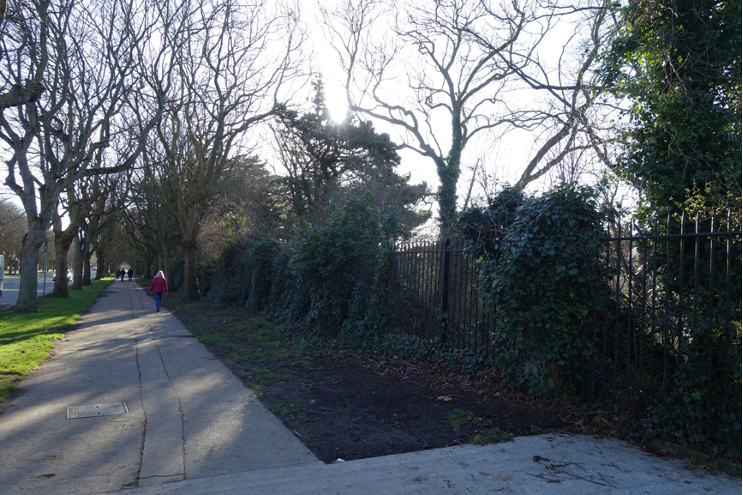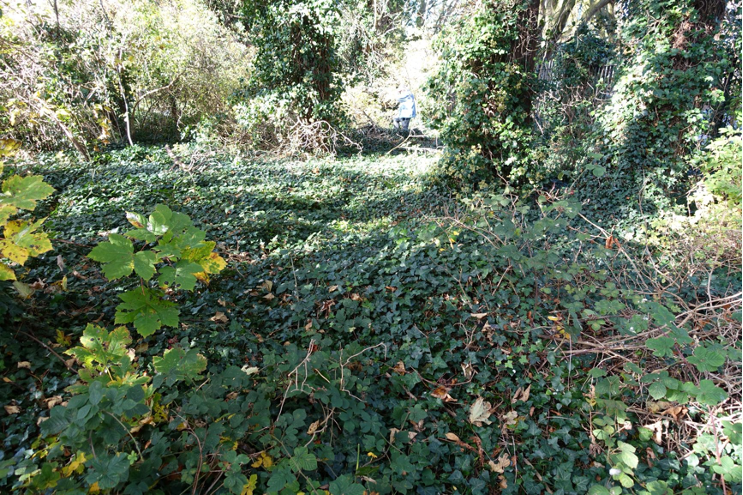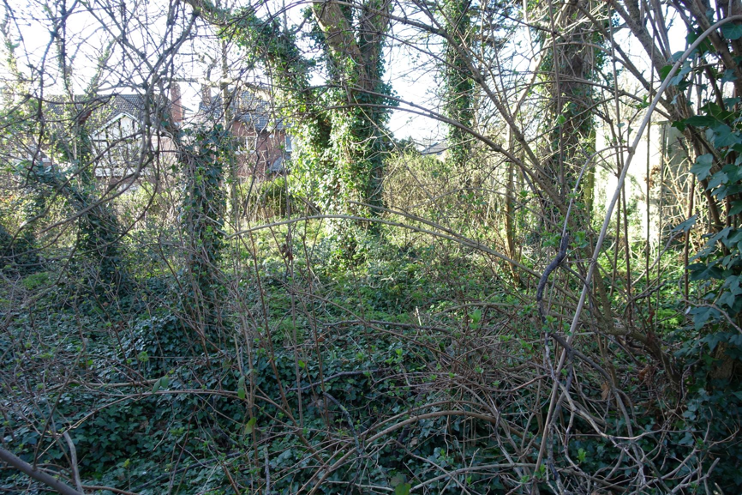Biodiversity Report on the wooded area at Beresford / Griffith Avenue, Drumcondra, Dublin 9
Background
In the course of the AHAA (virtual) meeting of 28 October 2020 a discussion arose about the wooded area at Beresford/Griffith Avenue in the context of the wildflower planting project along the adjacent verge on the Avenue. To inform the discussion, one of our Committee members offered that he and his wife would have a look at the site to take note of the existing flora and fauna and to see what, if anything, could be done to enhance the biodiversity potential of this small area and to report back to the Committee regarding this. The opportunity is taken particularly to thank one of our members from Beresford for her time and helpfulness when we first visited the area.
The AHAA Committee will now consider the report below and how we might take on board some of the recommendations. We welcome feedback, input and suggestions from our members. You can get in touch with us via our contact page here.
General Overview
Bounded by Griffith Avenue to the north, the Dominican College driveway to the west and Beresford Green and Beresford Avenue to the south and east respectively, this wooded area is approximately 100 metres long and 20 metres wide, with its long axis running east-west. Lying at the same elevation as Griffith Avenue and with adjacent ground sloping to the south, this generally level site is embanked along its southern perimeter with a redbrick-faced retaining wall of over one metre in height. The area is enclosed by either a wall or railings on all sides.

The wooded area carries a mix of mature evergreen and deciduous trees and wild and garden small trees and shrubs. Over 90% of the ground cover consists of Ivy. The extent of the mature tree canopy is enhanced by the contiguity of an almost unbroken double line of mature Plane trees on Griffith Avenue, beneath which the AHAA has recently initiated wildflower planting as part of the All-Ireland Pollinator Plan "Managed for Wildlife" national programme. This project has been welcomed and appreciated by Association members.
The overall size of this area of relatively dense and mature trees and shrubs affords Beresford an effective acoustic buffer to Griffith Avenue and presents a significant natural visual amenity along the length of the estate's northern boundary.
FLORA
The wooded area can be viewed as existing in three vegetative zones:
1. Tree canopy
Within the area, this consists mainly of mature conifers and a group of broadleaf trees towards the western end adjacent to the Dominican College wall. Some five or six large mature conifers, representing a variety of species, are disposed through the area and form a significant portion of the total canopy. Because the area is elevated above the land to its south along its east-west (long) axis, light penetration beneath the tall coniferous canopy is quite good – an important prerequisite for spring-flowering ground flora.

Outside the wooded area, the continuity of the tree canopy with that on Griffith Avenue and the adjacent wooded strip running east along the boundary wall of Hampton from Beresford to Gracepark Road provides a combined nature refuge of some extent.
2. Shrub layer
(a) Native species
This understorey to the tall tree canopy consists of native species that have most probably all arrived by natural agency. Elder, hawthorn, ash, holly, hazel and bramble – all characteristic constituent species of native Irish hedgerows and shrubland – are present, though only the first of these in any quantity. A single arching Rose near the southern perimeter has the general appearance of being a native species. Young self-seeded Sycamore is also present.
(b) Planted garden shrubs and small trees
A number of ornamental garden shrubs, planted along the southern perimeter, appear to have remained confined there, none observed to have seeded beyond the planted perimeter. These include Cotoneaster, Berberis, Variegated Laurel, Escallonia, Viburnum, Garrya and Ceanothus. There are single planted specimens of decorative Maple, Pendulous Birch, Cherry and Lilac just inside the southern perimeter. Gooseberry is also present, but could possibly be bird-sown.
3. Ground flora
The ground flora of the area is restricted by an extensive growth of Ivy covering almost its entirety. A small dry patch of ground on the south side of the area hosts a colony of Annual Mercury (Mercurialis annua)– a member of the Spurge family and one of the most characteristic plants of the Dublin flora, it being a species typically found in the city centre and older suburbs. Annual Mercury benefits wildlife by having a long flowering season that extends from March to October. Cow Parsley (Anthriscus sylvestris) is present within the wooded area, mainly beneath the broadleaf trees and in the verge on its northern edge. Such areas are a favoured situation for this species, as formerly seen within the Marino Institute/Cairn site and along the adjacent verge on Griffith Avenue where Cow Parsley flowered in great profusion in spring and early summer for many years. This early-emerging perennial is a beneficial food plant for flying insects, being one of the first sources of pollen for bees, hoverflies, moths and butterflies (particularly Orange Tips).
Cuckoo Pint (or Lords-and-Ladies) (Arum maculatum) , a common plant of shaded hedgerows and woodlands but a species which is very rare in north Co. Dublin, is present in small quantity in a few locations at the edge of the wooded area.
The lack of diversity in the ground flora of the area is manifested by the absence of ferns, sedges and fungi and the almost total absence of grass species. No invasive exotic species are apparent.

FAUNA
The combination of the mature tree canopy and relatively dense shrub layer provides good habitat for birdlife. Common species such as Robin, Blackbird and Wood Pidgeon are readily visible (and audible!). It is noteworthy that four native Irish species of Tit (Great, Blue, Coal and Long-tailed) were observed on a single visit. The presence of the lattermost is specifically interesting in that this tiny bird migrates eastwards in Ireland during winter in search of richer food habitats in woodland thickets, hedgerows and bushy areas. Such habitats are all in particular decline in the greater Dublin connurbation.
The evident level of birdlife is suggestive of a diverse insect community.
A mammal track runs east-west through the area, a short distance inside its southern perimeter. It may be continuous with the adjacent wooded strip along the Hampton boundary on Griffith Avenue.
The wooded area at Beresford in the wider context of the Griffith Avenue/Drumcondra locality
The disturbance of the development site at the former Marino Institute, which afforded extensive cover for mammals, insects and birds, is only the most recent of a number of developments in our area that have had a cumulative deleterious impact on the availability of viable tracts of habitat in the locality. For example, bat flight paths were documented as existing at the Marino Institute/Cairn site and there is anecdotal evidence of fewer sightings of bats and of raptors, such as sparrowhawks, in the locality in the last few years.
With future proposed developments set to further marginalise remaining wild flora and fauna in the general locality, relatively small pockets of suitable habitat, such as that at Beresford, become increasingly important as foraging, roosting and nesting places along the Griffith Avenue tree and garden corridor.
Possible community management interventions for enhanced biodiversity
The following possibilities may offer enhancement for biodiversity within the wooded area at Beresford, with relatively low initial input of effort and subsequent maintenance. (We are assuming that the existing open public access remains in place.)
Flora:
For the encouragement of native woodland spring-flowering species:

Fauna:
To maintain and enhance the use by wildlife of the continuous tree canopy and shrub layer in this area at Beresford and the adjacent wildlife corridors:
In the course of the AHAA (virtual) meeting of 28 October 2020 a discussion arose about the wooded area at Beresford/Griffith Avenue in the context of the wildflower planting project along the adjacent verge on the Avenue. To inform the discussion, one of our Committee members offered that he and his wife would have a look at the site to take note of the existing flora and fauna and to see what, if anything, could be done to enhance the biodiversity potential of this small area and to report back to the Committee regarding this. The opportunity is taken particularly to thank one of our members from Beresford for her time and helpfulness when we first visited the area.
The AHAA Committee will now consider the report below and how we might take on board some of the recommendations. We welcome feedback, input and suggestions from our members. You can get in touch with us via our contact page here.
General Overview
Bounded by Griffith Avenue to the north, the Dominican College driveway to the west and Beresford Green and Beresford Avenue to the south and east respectively, this wooded area is approximately 100 metres long and 20 metres wide, with its long axis running east-west. Lying at the same elevation as Griffith Avenue and with adjacent ground sloping to the south, this generally level site is embanked along its southern perimeter with a redbrick-faced retaining wall of over one metre in height. The area is enclosed by either a wall or railings on all sides.

The wooded area at Beresford runs for approx. 100 metres along the south side of Griffith Avenue (photo looks east).
The wooded area carries a mix of mature evergreen and deciduous trees and wild and garden small trees and shrubs. Over 90% of the ground cover consists of Ivy. The extent of the mature tree canopy is enhanced by the contiguity of an almost unbroken double line of mature Plane trees on Griffith Avenue, beneath which the AHAA has recently initiated wildflower planting as part of the All-Ireland Pollinator Plan "Managed for Wildlife" national programme. This project has been welcomed and appreciated by Association members.
The overall size of this area of relatively dense and mature trees and shrubs affords Beresford an effective acoustic buffer to Griffith Avenue and presents a significant natural visual amenity along the length of the estate's northern boundary.
FLORA
The wooded area can be viewed as existing in three vegetative zones:
1. Tree canopy
Within the area, this consists mainly of mature conifers and a group of broadleaf trees towards the western end adjacent to the Dominican College wall. Some five or six large mature conifers, representing a variety of species, are disposed through the area and form a significant portion of the total canopy. Because the area is elevated above the land to its south along its east-west (long) axis, light penetration beneath the tall coniferous canopy is quite good – an important prerequisite for spring-flowering ground flora.

A variety of mature conifers is a significant constituent of the tall tree canopy in the wooded area at Beresford (photo looks north-west)
Outside the wooded area, the continuity of the tree canopy with that on Griffith Avenue and the adjacent wooded strip running east along the boundary wall of Hampton from Beresford to Gracepark Road provides a combined nature refuge of some extent.
2. Shrub layer
(a) Native species
This understorey to the tall tree canopy consists of native species that have most probably all arrived by natural agency. Elder, hawthorn, ash, holly, hazel and bramble – all characteristic constituent species of native Irish hedgerows and shrubland – are present, though only the first of these in any quantity. A single arching Rose near the southern perimeter has the general appearance of being a native species. Young self-seeded Sycamore is also present.
(b) Planted garden shrubs and small trees
A number of ornamental garden shrubs, planted along the southern perimeter, appear to have remained confined there, none observed to have seeded beyond the planted perimeter. These include Cotoneaster, Berberis, Variegated Laurel, Escallonia, Viburnum, Garrya and Ceanothus. There are single planted specimens of decorative Maple, Pendulous Birch, Cherry and Lilac just inside the southern perimeter. Gooseberry is also present, but could possibly be bird-sown.
3. Ground flora
The ground flora of the area is restricted by an extensive growth of Ivy covering almost its entirety. A small dry patch of ground on the south side of the area hosts a colony of Annual Mercury (Mercurialis annua)– a member of the Spurge family and one of the most characteristic plants of the Dublin flora, it being a species typically found in the city centre and older suburbs. Annual Mercury benefits wildlife by having a long flowering season that extends from March to October. Cow Parsley (Anthriscus sylvestris) is present within the wooded area, mainly beneath the broadleaf trees and in the verge on its northern edge. Such areas are a favoured situation for this species, as formerly seen within the Marino Institute/Cairn site and along the adjacent verge on Griffith Avenue where Cow Parsley flowered in great profusion in spring and early summer for many years. This early-emerging perennial is a beneficial food plant for flying insects, being one of the first sources of pollen for bees, hoverflies, moths and butterflies (particularly Orange Tips).
Cuckoo Pint (or Lords-and-Ladies) (Arum maculatum) , a common plant of shaded hedgerows and woodlands but a species which is very rare in north Co. Dublin, is present in small quantity in a few locations at the edge of the wooded area.
The lack of diversity in the ground flora of the area is manifested by the absence of ferns, sedges and fungi and the almost total absence of grass species. No invasive exotic species are apparent.

A general view through the centre of the wooded area at Beresford (photo looks west). Ivy is the prevalent ground cover and ascends and clothes many of the trees. A self-seeded Sycamore is seen in the left foreground.
FAUNA
The combination of the mature tree canopy and relatively dense shrub layer provides good habitat for birdlife. Common species such as Robin, Blackbird and Wood Pidgeon are readily visible (and audible!). It is noteworthy that four native Irish species of Tit (Great, Blue, Coal and Long-tailed) were observed on a single visit. The presence of the lattermost is specifically interesting in that this tiny bird migrates eastwards in Ireland during winter in search of richer food habitats in woodland thickets, hedgerows and bushy areas. Such habitats are all in particular decline in the greater Dublin connurbation.
The evident level of birdlife is suggestive of a diverse insect community.
A mammal track runs east-west through the area, a short distance inside its southern perimeter. It may be continuous with the adjacent wooded strip along the Hampton boundary on Griffith Avenue.
The wooded area at Beresford in the wider context of the Griffith Avenue/Drumcondra locality
The disturbance of the development site at the former Marino Institute, which afforded extensive cover for mammals, insects and birds, is only the most recent of a number of developments in our area that have had a cumulative deleterious impact on the availability of viable tracts of habitat in the locality. For example, bat flight paths were documented as existing at the Marino Institute/Cairn site and there is anecdotal evidence of fewer sightings of bats and of raptors, such as sparrowhawks, in the locality in the last few years.
With future proposed developments set to further marginalise remaining wild flora and fauna in the general locality, relatively small pockets of suitable habitat, such as that at Beresford, become increasingly important as foraging, roosting and nesting places along the Griffith Avenue tree and garden corridor.
Possible community management interventions for enhanced biodiversity
The following possibilities may offer enhancement for biodiversity within the wooded area at Beresford, with relatively low initial input of effort and subsequent maintenance. (We are assuming that the existing open public access remains in place.)
Flora:
For the encouragement of native woodland spring-flowering species:
- the clearance of some ground under the broadleaf trees at the western end of the wooded area of Ivy and its light scarification, followed by leaving it fallow for one annual rotation to allow any dormant seed bank to manifest. Thereafter, that part of the area to be managed appropriately for this objective, including the prevention of encroachment of the surrounding ground cover on any emergent woodland flora;
- continuation of AHAA's initiative of Management for Wildlife along the Griffith Avenue perimeter of the site, particularly with a view to improving the diversity of insect food plants.

Good natural light and a sheltered aspect make the area beneath the group of broadleaf trees at the western end of the wooded area suitable for encouraging the emergence of native spring flora (photo looks south).
Fauna:
To maintain and enhance the use by wildlife of the continuous tree canopy and shrub layer in this area at Beresford and the adjacent wildlife corridors:
- the introduction of bird boxes, in particular to encourage the residency of less common species, such as the Long-tail Tit, whose national numbers are approximately only one-tenth of those of the more common members of its family;
- the exploration with a relevant expert group (for example, the Dublin Bat Group) of the feasibility of this area at Beresford as a roosting location for bat species known to have foraged in the locality, to prevent or reverse their disappearance due to the loss of habitat attendant on the ongoing division of institutional lands in the locality for development.
